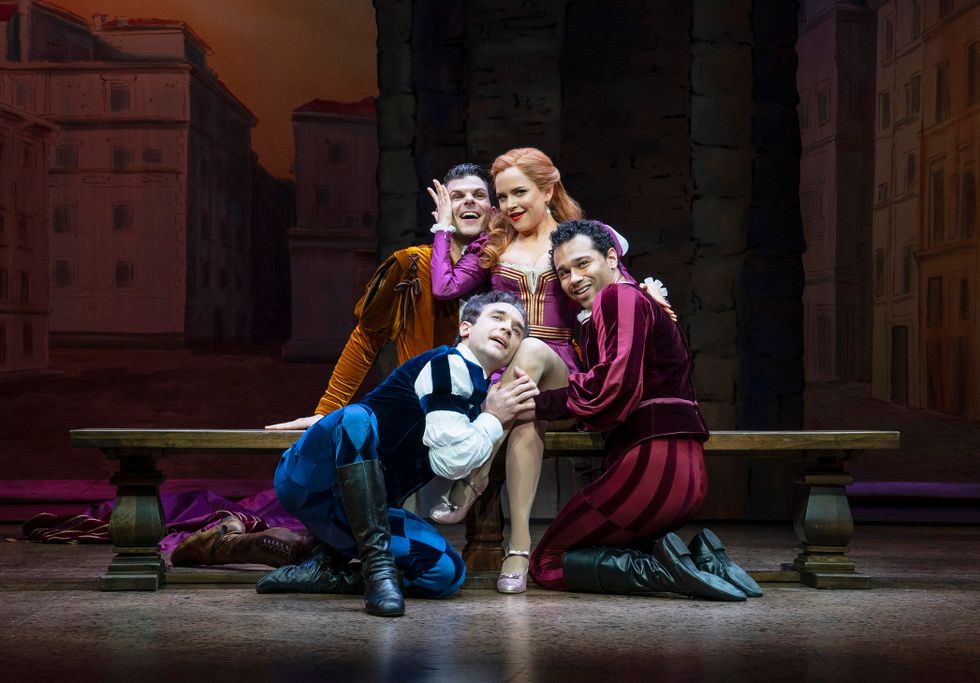Anatomy of a Broadway Show: Warren Carlyle Breaks Down Kiss Me, Kate's Dance Numbers
When it comes to musicals, they sure don’t make ’em like they used to. Case in point: When Kiss Me, Kate premiered in 1948, integrated musicals—shows that produced genuine emotions and had music and lyrics closely tied to the script, rather than comedies or revues—were still a fairly new trend. In fact, Kiss Me, Kate was Cole Porter’s first stab at this structure. Fast forward to 2019, and it’s hard not to notice that some numbers feel like they’re barely related to the narrative.
Scratch your head all you want (Why are they singing and dancing again? And how exactly does it move the plot forward?), but there’s a major upside to this structure: It gave choreographer Warren Carlyle a lot of room to play when choreographing Studio 54’s current revival.
“Kiss Me, Kate—really more than anything I’ve ever done—has really, really tested my range,” says Carlyle, who snagged a Drama Desk nomination for outstanding choreography. “It was an interesting challenge for me in that each and every single number had a different approach.”
He broke down the motivation behind some of the show’s danciest songs.
“Tom, Dick or Harry”
The number:
In Kiss Me, Kate, the characters are putting on a production of The Taming of the Shrew. This humorous song, in the play-within-a-play, revolves around three men competing for Bianca’s heart through dance.
The approach:
” ‘Tom, Dicky or Harry’ was character-driven, and I knew I needed three different dancers for three different suitors at three different temperatures. The first one is very, very jazzy, tries really hard, and the second one is cool, cool, cool. The third one is full of heart.”

“Tom, Dick or Harry” from Kiss Me, Kate
Photo by Joan Marcus, Courtesy LSG Public Relations
“We Sing of Love (Cantiamo D’Amore)”
The number:
The Taming of the Shrew
is set in Italy, so the cast sings a joyous Italian love song, complete with women dancing barefoot in barrels of grapes.
The approach:
” ‘Cantiamo D’Amore’ is actually quite classical. There’s a tarantella in there, the tambourines, all of the beautiful partnering in the barrels. We don’t have much partnering in the show, so the number became about that and celebrating women. I knew they’d have to remove their shoes and stockings for the grape stomping, so I ended up choosing for them to be barefoot,” he says.
“Too Darn Hot”
The number:
At the top of Act II, the cast takes a break during The Shrew‘s intermission. They’re hanging out in the alley outside the stage door, it’s stifling hot and they break into a classic, ’40s-style jazz number.
The approach:
“It’s all about emotion and the battle of the sexes. The men do a section, and then the women are going to automatically do better in the next section.
‘Too Darn Hot’ became this climb, this wonderful release at intermission when they’re in the back alley. It’s an opportunity for the dancers to take it and do something really meaningful.”
“Always True to You in My Fashion”
The number:
New actress Lois Lane (Stephanie Styles) has a voracious appetite for flirtation, but she uses this song to assure beau Bill Calhoun (Corbin Bleu) of her devotion. The number takes place backstage, where props provide inspiration for the dancing.
The approach:
‘ “Always True to You in My Fashion” was about her dexterity with these props, like the plank and the ladder and the rolling wardrobe rack. It was about giving life to three really good ideas and just letting her play in the playground that is backstage.”
“Bianca”
The number:
“Bianca” is Bill Calhoun’s answer to “Always True to You in my Fashion” and his declaration of love to Lois Lane/Bianca. It’s stocked with “fast, machine-gun tapping,” describes Carlyle, and it even involves Bleu inverting himself and dancing on the ceiling of part of the set.
The approach:
Carlyle admits that it took him three or four tries to get the choreography right.
“It comes at an interesting time in the show, what I think of as the three-quarter mark. Up until that point, choreographically, I’ve been punching and punching and punching, and it’s been very athletic and percussive.
“I wrote in my script, ‘Don’t try too hard.’ It’s a charm number where he’s basically saying, “I love you no matter what.” I made something in the rehearsal studio that was quite charming, and then when I got it onstage, I had David Rockwell’s incredible three-story set that I was not using. It looked like a missed opportunity, so I spread the dance into three levels.
“Corbin is wonderful, but I wasn’t quite serving him well enough. It was a 5 out of 10, and that’s my work, not him. So I really went to work on it. We added the ladies dancing. We added a stair dance for him.
“And then I sat in the third row, and all I could see was the ceiling. He’d danced everywhere else, so I thought, Well, I have to get Corbin’s feet on that ceiling. And that was the journey of ‘Bianca.’ ”

Photo by Joan Marcus, Courtesy LSG Public Relations




